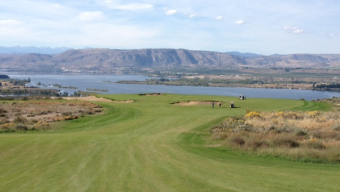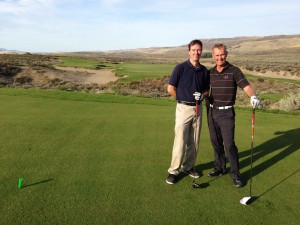BREWSTER, Wa. – As a child growing up in his native Scotland in the 1970s, David McLay Kidd watched the telly with wonder as the Masters unfolded amid the lush spring beauty of Augusta National.
He did wonder. Puzzled.
“Everyone held up Augusta National as the absolute epitome of golf. I looked at it and thought, “that’s not golf. Why is 1,000 azalea plants golf? That’s not the golf I was brought up with,’ ” said Kidd, the son of Jimmy Kidd, the noted Gleneagles (Scotland) golf courses greenskeeper.
At some point over the past 100 years, he believes, America lost its way. Courses changed, from rough-and-tumble to clean-and-pristine. Augusta was part of that pattern and hundreds followed. Country clubs got all fancy. The PGA Tour featured those manicured beauties, adding prissy and exclusivity by featuring telegenic courses that only members could play.
“About halfway through the century, after the second World War, old man Jones (Robert Trent Jones) started building golf courses and they became Americanized, what I would call country-club golf, lush, green, manicured, garden-esque, water appearing everywhere,” Kidd said. “And it kind of lost the traditions of the game. It no longer became a game of bounce and roll, it became a game of throwing darts. And very unnatural.
“American convention 15 years ago was blue-grass fairways, bent greens, splash bunkers, flat lies in fairway, fairways 25 to 40 yards wide, cart paths, the clubhouse (located) in the most prominent spot in the landscape,” added Kidd, reeling off all the necessary components. “American conventions for golf courses were and still are extremely different from the British Isles.”
Kidd mentioned 15 years ago because that’s when he arrived, both in America and as a golf course designer. Kidd got the break of his life as a 27-year-old in 1998 when a Chicago businessman with a dream, Mike Keiser, locked in on this Kidd and selected him to design Bandon Dunes, the now world-renown links course on the southern Oregon coast. When completed, it was immediately named a top 10 course in the world. Think what that did to Kidd’s head.
“Did I want people to love it and come and play it? Yes, of course I did,” he said. “Did I think it would happen? Maybe, maybe not. When it did happen, I was as shocked as Mike. We never expected the huge tidal wave of affection for Bandon Dunes. Huge shock.
“Golf Digest said I was the next superstar. At that moment, I thought, ‘Holy shit, I’ve been given this massive, massive star. Like having a No. 1 hit right out of the box. I realized, instead of sitting back and thinking, ‘look how clever I am.’ I said to myself, ‘I got the best site in America and I built a pretty good golf course. I better make sure I don’t screw up the next one. I better not be one of these one-hit wonders who never builds another good golf course.’ ”
He drifted in that one-hit direction but, with an epiphany, pulled himself out of it (more on that later). But where this designing journey has brought him today is to the secluded central Washington city of Brewster. Tiny town, apple orchards, brown hills, granite till and the mighty Columbia cutting through with a wide swath.
He just finished Gamble Sands – opening next summer – a 600-acre links complex on a deep-sand based bluff overlooking the Columbia. (Here’s Jim Street’s hole-by-hole perspective on Gamble Sands).
As remote and as strange a place for a magnificent golf course as Bandon once was, perhaps, Kidd believes one day Gamble Sands can be close to what Bandon has become.
“I wanted the same experience as Bandon Dunes. I think I did that,” Kidd said. “I think that is the experience people will have here. The difference is, they’ll be playing in shorts, without blue legs.”
It definitely will be hotter in the summer than Bandon but not nearly as windy. There also are plenty of vistas, as 12 holes have a water view (confluence of the Columbia, Okanagan and Methow rivers). It is pure links – fescue, large waste areas, tight lies, rolling terrain, hard-and-fast, and fair. Especially fair. That’s what he wanted built into the course most of all. Fairness equals enjoyment in his mind.
He wanted the average golfer to shoot below his average while still being tested. The fairways are wide and the greens large. There are no water hazards. You have to really jack one left or right to lose a ball.
A decade ago, Kidd might not have been the guy to do this course. After Bandon, he went on down a different path.
“I built right at the end of that economic boom when everyone was talking about defending par, and good resistance to scoring and levels of difficulty, I got sucked into that romance as well,” Kidd said.
Kidd is not too proud to admit that while his designed Bend, Ore., course, Tetherow, might be visually appealing and critically acclaimed, it punished the average golfer when it opened. The same could be said for his St. Andrews Links Castle course he was authorized to design.
“I built a couple courses like that, that were difficult. I get to play one in Bend, my home course. That took some of the fun and enjoyment out of the game. What I wanted to do here (Gamble Sands) was put it back in, where the average golfer has a great time and wants to play it over and over again. And the good golfer can stand there, see opportunities hopefully and be aggressive without being overly penalized.”
The course got its name from one of the first prominent families in the area, the Gambles, who settled in the 1880s. The Gambles married the Gebbers and their union built one of the largest growers of apples and cherries in the nation. The family, now in the fifth generation, owns about 100,000 acres and employs about 2,500.
The name was actually suggested by a sportswriter, Tony Dear, who lives in Bellingham, Wa. He said it honors the family name as well as provides a description of the course’s primary ingredient, sand. Kidd and the Gebbers liked it immediately.
Cass Gebbers championed the idea of a destination golf site as a benefit to the community, for jobs and tourism. The original golf site was on a bluff above Brewster and Perry Dye was brought in to design the course. It is on a much more rocky and difficult terrain. Three holes were completed before work was suspended after the 2008 economic downturn.
A much more sandy and accommodating site was selected four years ago and Kidd was brought into the project, based on his links reputation. It was relatively cheap to build because not much earth needed to be moved and much of the heavy equipment, and labor, was already in place with the orchard business.
“I came up to the plateau here and looked at 600-700 acres that wasn’t planned for orchards, and they said what can do you do with it? My chin dropped,” Kidd said. “It was on sand. There was no limitations, no real estate. The land was absolutely superb.
“There were no excuses. I couldn’t blame the other designer. I couldn’t blame the lack of water. If it’s crap, it’s all my fault.”
It’s not crap.
It’s been a metamorphosis of sorts for Kidd. He had his major Bandon splash that was followed courses difficult by design yet generally still true to his links roots. He has tamed that hard-to-play spirit. Gamble Sands is a full return to Bandon-esque. That’s where he started, where he made his name and where he is heading now with Gamble Sands.
“My hope is I can continue to lay a foundation of really great courses, not a bad round in there,” he said. “So I would like my place in history is to bring golf back to where it was 100 years ago when it first got here in America. Bandon Dunes represents that. It’s unadulterated, play it as it lies, use your imagination, use your creativity, use whatever you have to figure your way through the golf course.
“And it continues here.”























Pingback: A hole-by-hole look at Gamble Sands | Golfers West